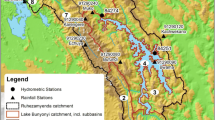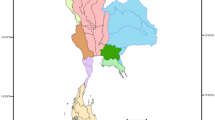Abstract
An integrated process involving participatory and modelling approaches for prioritizing and evaluating climate change adaptation options for the Kangsabati reservoir catchment is presented here. We assess the potential effects of climate change on water resources and evaluate the ability of stakeholder prioritized adaptation options to address adaptation requirements using the Water Evaluation And Planning (WEAP) model. Two adaptation options, check dams and increasing forest cover, are prioritized using pair-wise comparison and scenario analysis. Future streamflow projections are generated for the mid-21st century period (2021–2050) using four high resolution (~25 km) Regional Climate Models and their ensemble mean for SRES A1B scenario. WEAP simulations indicate that, compared to a base scenario without adaptation, both adaptation options reduce streamflow. In comparison to check dams, increasing forest cover shows greater ability to address adaptation requirements as demonstrated by the temporal pattern and magnitude of streamflow reduction. Additionally, over the 30 year period, effectiveness of check dams in reducing streamflow decreases by up to 40 %, while that of forest cover increases by up to 47 %. Our study highlights the merits of a comparative assessment of adaptation options and we conclude that a combined approach involving stakeholders, scenario analysis, modelling techniques and multi-model projections may support climate change adaptation decision-making in the face of uncertainty.







Similar content being viewed by others
References
Adger WN, Arnell NW, Tompkins EL (2005) Successful adaptation to climate change across scales. Glob Environ Chang 15(2):77–86
Allen RG, Pereira LS, Raes D, Smith M (1998) Crop evapotranspiration—guidelines for computing crop water requirements—FAO Irrigation and drainage paper 56, FAO, Rome
Arnell N (2010) Adapting to climate change: an evolving research programme. Clim Chang 100:107–111
Bandyopadhyay A, Bhadra A, Swarnakar RK, Raghuwanshi NS, Singh R (2012) Estimation of reference evapotranspiration using a user-friendly decision support system: DSS_ET. Agric For Meteorol 154:19–29
Bhave AG, Mishra A, Groot A (2013) Sub-basin scale characterization of climate change vulnerability, impacts and adaptation in an Indian River basin. Reg Environ Chang 1–12. doi:10.1007/s10113-013-0416-8
Central Ground Water Board. Water level information, Ground Water Information System. URL: http://gis2.nic.in/cgwb/Gemsdata.aspx
Coreau A, Pinay G, Thompson JD, Cheptou PO, Mermet L (2009) The rise of research on futures in ecology: rebalancing scenarios and predictions. Ecol Lett 12(12):1277–1286
de Bruin K, Dellink RB, Ruijs A, Bolwidt L, van Buuren A, Graveland J, de Groot RS, Kuikman PJ, Reinhard S, Roetter RP, Tassone VC, Verhagen A, van Ierland EC (2009) Adapting to climate change in the Netherlands: an inventory of climate adaptation options and ranking of alternatives. Clim Chang 95:1–2
De Winnaar G, Jewitt GPW, Horan M (2007) A GIS-based approach for identifying potential runoff harvesting sites in the Thukela River basin, South Africa. Phys Chem Earth 32(15):1058–1067
Govt. of India (2008) National action plan on climate change. URL: http://pmindia.gov.in/climate_change_english.pdf
Govt. of West Bengal (2003) Performance evaluation study and system analysis of Kangsabati reservoir project. Vol. I and II
Hajkowicz S, Collins K (2007) A review of multiple criteria analysis for water resource planning and management. Water Resour Manag 21(9):1553–1566
Huntjens P, Lebel L, Pahl-Wostl C, Camkin J, Schulze R, Kranz N (2012) Institutional design propositions for the governance of adaptation to climate change in the water sector. Glob Environ Chang 22(1):67–81
Im ES, Jung IW, Chang H, Bae DH, Kwon WT (2010) Hydroclimatological response to dynamically downscaled climate change simulations for Korean basins. Clim Chang 100(3–4):485–508
Immerzeel WW, Bierkens MFP (2012) Asia’s water balance. Nat Geosci 5(12):841–842
Mathison C, Wiltshire A, Dimri AP, Falloon P, Jacob D, Kumar P, Moors E, Ridley J, Siderius C, Stoffel M, Yasunari T (2012) Regional projections of North Indian climate for adaptation studies. Sci Total Environ 365. doi:10.1016/j.scitotenv.2012.04.066
Mehta VK, Haden VR, Joyce BA, Purkey DR, Jackson LE (2013) Irrigation demand and supply, given projections of climate and land-use change, in Yolo County, California. Agric Water Manag 117:70–82
Mittal N, Mishra A, Singh R (2013) Combining climatological and participatory approaches for assessing changes in extreme climatic indices at regional scale. Clim Chang. doi:10.1007/s10584-013-0760-1
Moors EJ, Groot A, Biemans H, Terwisscha van Scheltinga C, Siderius C, Stoffel M, Huggel C, Wiltshire A, Mathison C, Ridley J, Jacob D, Kumar P, Bhadwal S, Gosain A, Collins DN (2011) Adaptation to changing water resources in the Ganges basin, northern India. Environ Sci Pol 14(7):758–769
Moriasi D, Arnold J, Van Liew M, Bingner R, Harmel R, Veith T (2007) Model evaluation guidelines for systematic quantification of accuracy in watershed simulations. Trans ASABE 50:885–900
Purkey DR, Joyce B, Vicuna S, Hanemann MW, Dale LL, Yates D, Dracup JA (2008) Robust analysis of future climate change impacts on water for agriculture and other sectors: a case study in the Sacramento Valley. Clim Chang 87(1):109–122
Ramakrishnan D, Bandyopadhyay A, Kusuma KN (2009) SCS-CN and GIS-based approach for identifying potential water harvesting sites in the Kali Watershed, Mahi River Basin, India. J Earth Syst Sci 118(4):355–368
Refsgaard JC, Arnbjerg-Nielsen K, Drews M, Halsnæs K, Jeppesen E, Madsen H, Markandya A, Olesen JE, Porter JR, Christensen JH (2013) The role of uncertainty in climate change adaptation strategies—a Danish water management example. Mitig Adapt Strateg Glob 18(3):337–359
Stonestrom DA, Scanlon BR, Zhang L (2009) Introduction to special section on impacts of land use change on water resources. Water Resour Res 45(7)
Verburg PH, Koomen E, Hilferink M, Pérez-Soba M, Lesschen JP (2012) An assessment of the impact of climate adaptation measures to reduce flood risk on ecosystem services. Landsc Ecol 27(4):473–486
Yates D, Sieber J, Purkey D, Huber Lee A, Galbraith H (2005a) WEAP21: a demand, priority, and preference driven water planning model: part 2, aiding freshwater ecosystem service evaluation. Water Int 30(4):487–500
Yates D, Sieber J, Purkey D, Huber Lee A (2005b) WEAP21: a demand, priority, and preference driven water planning model: part 1, model characteristics. Water Int 30(4):501–512
Acknowledgments
This work has been supported by the HighNoon project, funded by the European Commission Framework Programme 7 under Grant Nr. 227087.
Author information
Authors and Affiliations
Corresponding author
Electronic supplementary material
Below is the link to the electronic supplementary material.
ESM 1
(DOCX 175 kb)
Rights and permissions
About this article
Cite this article
Bhave, A.G., Mishra, A. & Raghuwanshi, N.S. Evaluation of hydrological effect of stakeholder prioritized climate change adaptation options based on multi-model regional climate projections. Climatic Change 123, 225–239 (2014). https://doi.org/10.1007/s10584-014-1061-z
Received:
Accepted:
Published:
Issue Date:
DOI: https://doi.org/10.1007/s10584-014-1061-z




